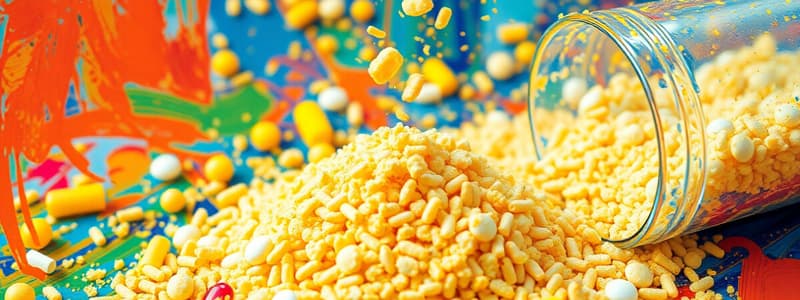Podcast
Questions and Answers
What is dry granulation and when is it typically used?
What is dry granulation and when is it typically used?
Dry granulation is a process of powder granulation by compression without using heat or solvent, typically used when drugs are heat or moisture sensitive and cannot be directly compressed.
What are the two primary methods of dry granulation?
What are the two primary methods of dry granulation?
The two primary methods of dry granulation are the slugging technique and the roller compaction technique.
Describe the slugging technique in the dry granulation process.
Describe the slugging technique in the dry granulation process.
In the slugging technique, the powder mixture is compressed into large tablets called slugs, which are then milled into granules.
How does roller compaction differ from slugging in dry granulation?
How does roller compaction differ from slugging in dry granulation?
What is a slug in the context of dry granulation?
What is a slug in the context of dry granulation?
List at least two advantages of dry granulation over wet granulation.
List at least two advantages of dry granulation over wet granulation.
Why is dry granulation particularly useful for effervescent tablets?
Why is dry granulation particularly useful for effervescent tablets?
What role does the binder play in the dry granulation process?
What role does the binder play in the dry granulation process?
Explain how dry granulation ensures uniform distribution of active ingredients.
Explain how dry granulation ensures uniform distribution of active ingredients.
What happens to the granules produced through roller compaction?
What happens to the granules produced through roller compaction?
Flashcards
Dry Granulation
Dry Granulation
A powder granulation process using compression without heat or solvent.
Dry Granulation Methods
Dry Granulation Methods
Two techniques to generate granules: slugging and roller compaction.
Slugging Technique
Slugging Technique
Pre-compressing a powder mixture into large tablets (slugs), then milling them to create granules.
Slug
Slug
Signup and view all the flashcards
Roller Compaction
Roller Compaction
Signup and view all the flashcards
Roller Compaction Advantages
Roller Compaction Advantages
Signup and view all the flashcards
Dry Granulation Use Cases
Dry Granulation Use Cases
Signup and view all the flashcards
Cohesive properties
Cohesive properties
Signup and view all the flashcards
Lubricant
Lubricant
Signup and view all the flashcards
Tablet press
Tablet press
Signup and view all the flashcards
Study Notes
Dry Granulation
- Process of creating granules from powder by compression without heat or solvents.
- Used when drugs cannot be directly compressed (high dose, flowability issues) or are heat/moisture sensitive.
- Cohesive properties of the active ingredient or diluent are crucial.
Methods of Dry Granulation
- Slugging Technique:
- Ingredients are weighed and mixed.
- Powder mixture is compressed (pre-compressed) into large, flat tablets called slugs.
- Slugs are milled into granules.
- Slugs are large compacts, about 1 inch in diameter. They are not tablets because they don't meet tablet evaluation/assay standards.
- Lubricant is added to enhance powder flow and prevent sticking during precompression. Half the amount compared to the regular tablet formula.
- Roller Compaction Technique:
- Two rolls rotate, increasing powder density by pressing into a thin sheet or ribbon (similar to a slug).
- Sheet/ribbons (aggregates) are screened to produce uniform granules.
- Handles large material volumes quickly.
Advantages of Dry Granulation
- Requires less equipment and space compared to wet granulation.
- Suitable for heat/moisture-sensitive drugs (e.g., effervescent tablets).
- Faster disintegration than wet granulation due to binder use in powder form.
- Improved dissolution for easily soluble compounds.
- Ensures uniform active ingredient distribution.
Disadvantages of Dry Granulation
- Needs specialized equipment.
- Dust generation is possible, increasing cross-contamination risk.
- May hinder dissolution of insoluble drugs.
Studying That Suits You
Use AI to generate personalized quizzes and flashcards to suit your learning preferences.




